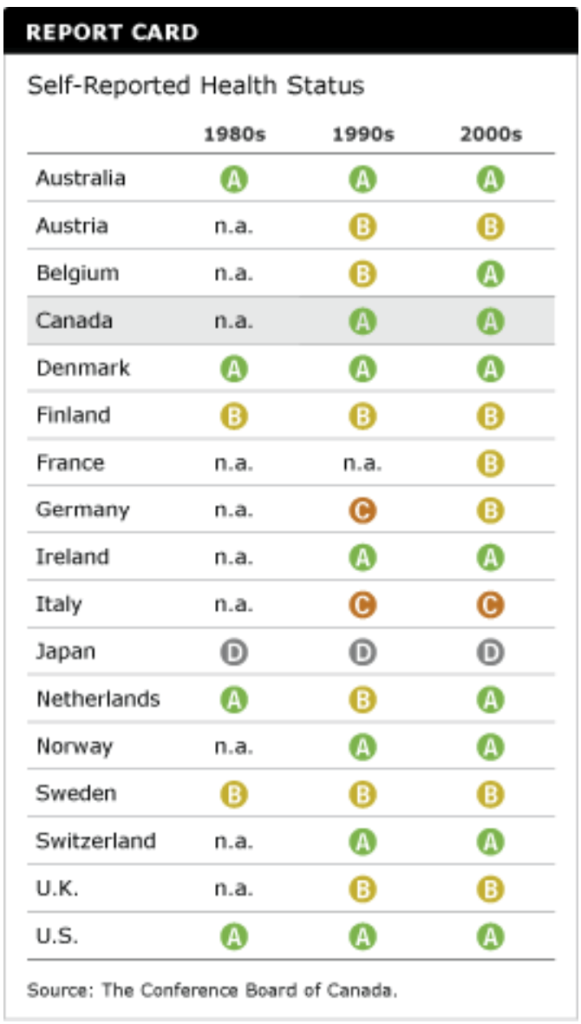Self-Reported Health Status
Key Messages
- Canada is bumped to 2nd among the 17 peer countries, as the U.S. regains its 1st place ranking.
- A full 88.5 per cent of Canadians report their health to be “good” or “very good,” well above the 17-country average of 76 per cent.
- People’s perceptions of their own health are not necessarily a good predictor of mortality rates—Japan ranks the worst on self-reported health status, but has some of the lowest mortality rates among its peers.
Putting self-reported health status in context
“In general how would you rate your health?” This is one of the most frequently asked questions to assess health status. Self-reported health status is now among the most common measures used in public health surveys in Canada and its peer countries. It represents physical, emotional, and social aspects of health and well-being. How people feel about their own health is seen as a good indication of the burden of disease.
The self-reported health status indicator complements the life expectancy indicator, which has sometimes been criticized as placing too much importance on quantity of life and not enough on quality of life.
Is the self-reported health status indicator too subjective?
Some researchers suggest a person’s judgment about his or her health is too subjective. Others note that cultural differences between countries will influence how people evaluate their health. Still, people’s perceptions of their own health have been found to be a good predictor of future health-care use and of mortality rates.
Self-reported health status may also reflect aspects of health—such as disease severity and undiagnosed disease—that are not captured in the more objective measures of health status. Good-to-excellent self-reported health status correlates with lower risk of mortality.1 Poor self-reported health status can be a good predictor of subsequent illness and premature death.2
Self-reported health status is also linked to age, with older people more likely to report poor health than younger people.
Do Canadians feel healthier than their peers in other countries?
Canada is near the top of the class on this indicator, with 88.5 per cent of Canadians reporting their health to be good or very good. Only the U.S. ranks ahead of Canada on this indicator—90 per cent of Americans report good or very good health. Both countries are well above the 17-country average of 76 per cent.
Interestingly, Japan has the lowest proportion of citizens reporting good or very good health status, and yet the longest life expectancy, one of the lowest premature mortality rates, the second-lowest mortality rate due to cancer, and the lowest rates of mortality due to circulatory diseases, diabetes, and mental illness. While Japan’s health outcomes continue to improve, the perceived health status of the population continues to fall. Between 2004 and 2007, the proportion of Japanese reporting their health to be good or very good dropped 6 percentage points, from 39 per cent to 33 per cent. One reason for Japan’s poor showing on this indicator could be its older, aging population—as noted earlier, older people are more likely to report poorer health.
Japan is the only country to score a “D” on this indicator. Canada and 11 of its peer countries earn “A” grades while France, Germany, Finland, and Italy all earn “B”s.

Do Canadians rate their health as high as they did in the past?
The percentage of adults rating their health as being good or very good has remained generally stable over the past two decades in countries where historical data are available. Canada earned “A”s in the 1990s and 2000s. The only countries to improve their grades from the 1990s to the 2000s were Germany, Belgium, and the Netherlands. Japan has maintained a “D” for the past three decades.
Footnotes
1 E.L. Idler and Y. Benyamini, “Self-Rated Health and Mortality: A Review of Twenty-Seven Community Studies,” Journal of Health and Social Behavior, 38, 1 (March 1997), 21–37.
2 J. McCallum et al., “Self-reported Health and Survival: A 7-year Follow-up Study of Australian
Elderly,” American Journal of Public Health, 84, 7 (July 1994), 1100–1105.

